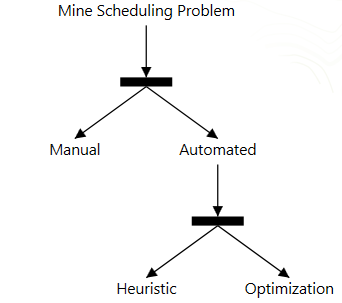Mine planners know their business. They know their sites and the value of their work. I’ve had the privilege of working with a lot of great ones, and every time I get the chance to have a conversation with them about their operations I am impressed with the depth and complexity of what they are each dealing with.
What I’ve also discovered is that there is a lot of noise that hinders the mine planner from knowing exactly how their primary tools perform the mine scheduling task. This noise enters the picture in all kinds of ways, and over time I believe it has clouded our perspective on how we are dealing with the problem at hand. Let’s look at this from the ground up – there are really two basic methods of creating a deterministic mine schedule: manual or automated.
Manual Scheduling
Manual scheduling is just that; while usually augmented with a mine design software interface, all decisions are made by the hand of the mine planner. As a result, the success of the resultant schedule is almost always reliant on the capability/expertise/experience of the individual.
Automated Scheduling
Automated scheduling is a way of expressing the mine scheduling problem in software to generate a solution for the engineer. Because software has evolved greatly over time, there are assorted methods for integrating important mining parameters into software and producing the desired solution.
This is where the noise comes in.
To try and distill this down further, let’s expand on the two broad types of automated scheduling methods: Heuristics and Optimization.
Heuristic Scheduling
Many of the automated scheduling software packages in the market today use some form of heuristic approach or even a combination of different heuristic methods. You can be assured you are working with a heuristic if you notice words such as genetic or fitness or target-based or meta-whatever in the description. Unfortunately, you will also notice in these same contexts the misuse of the word optimization.
Heuristics are sometimes favored due to their speed in processing big problems. They also give users the ability to target something, such as material tonnage or grade, or possibly some measure of value. All of these things are important to a mine planner.
Heuristic methods, however, cannot mathematically guarantee that the solution will meet a single or a combination of constraints (whether that’s maximum milling tonnage, minimum milling grade, maximum truck hours, or others). That’s a bit of a tough spot for mine planners, as they are often dealing with hard constraints.
Further, because of the way the underlying algorithms are seeking paths to solutions, they also sometimes have issues with repeatability. Repeatability is critically important if your work is to support a business plan which may later be audited by a third party. By using a heuristic method, you are not only challenged to arrive at a solution that meets your conditions, but you are also faced with the real possibility of getting a different answer when you click the “solve” button again.
So what else is there?
Optimized Scheduling
Enter ‘real’ optimization. This is an automated means of generating the mathematically optimum solution after considering all other feasible alternatives. Feasibility in mine scheduling equates to enforcing spatial precedences and honoring all production or grade constraints. This method is far more computationally intensive as the software’s underlying algorithms have to search through the entire feasible solution space to isolate the ‘best’ solution, whatever the definition of ‘best’ may be. For many strategic mine scheduling problems, ‘best’ usually means maximizing NPV.
Some mine planners may have discounted schedule optimization because the processing of large problems takes much more time than a heuristic approach. I fully appreciate that time is a limited commodity. The application of optimization technology has evolved greatly over the past few years, and the way a software application translates the complexities of the mine scheduling problem into those solving engines has improved significantly in overall speed/performance.

Minemax Scheduler is one of the mine scheduling solutions on the market that uses NPV schedule optimization to generate practical and optimal solutions for mine planners of nearly all mineral commodities. Through modern optimization technology, Scheduler delivers a solution that is mathematically guaranteed to meet the constraints imposed.
Also, because of the nature of the process, it is repeatable. To find out more on how we harness the power of optimization to solve the myriad of complications in the mine scheduling space, view our integrated approach example.
At the end of the day, the best tool for a mine planner depends ultimately on what they are dealing with. I hope this short dialog has helped clarify some of the realities in this space.
Still confused by the noise? Check out this really good write-up on the different optimization approaches for mine planners.

